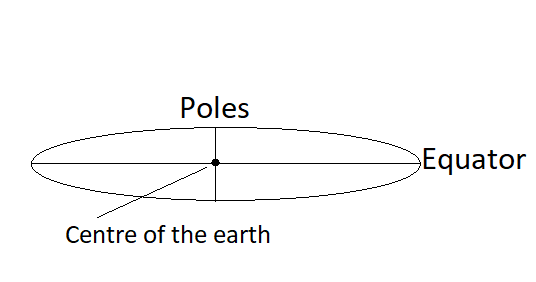
A person moves from pole to equator, then the value of his weight will-
A. Decrease
B. Increase
C. Remain same
D. First increase and then decrease
Answer
474.6k+ views
Hint: So, at first we need to understand the question and draw a pictorial representation of the person, now we know that if we move far from the center of the earth then the gravitational pull of the earth decreases which affects the weight of a body.
Formula used: W=mg
Complete step by step answer:

According to the question we know that the person is moving from the pole to the equator, here in the diagram I represented a 2-dimensional diagram of the earth and at one end there is a pole and at another side there is the equator.
We know that the earth is not fully a circle, it is a bit wider at the equator, so we can say that when a person is at the equator he is more farther from the center of the earth compared to the person standing in the poles.
So, from the above explanation we can say that the person will feel maximum weight at the poles as it is near to the center of the earth and at the equator the person will feel minimum weight because it is far from the center of the earth when compared to the poles.
We know that weight on the earth depends on mg, but ‘m’ is a constant value so weight (W) will depend on g.
So we know that the value of g at equator is $9.78m/{{s}^{2}}$
And the value of g at the poles is $9.83m/{{s}^{2}}$.
So, we can now clearly say that the value of weight in the equator is minimum and maximum at the poles.
So when the person moves from poles to the equators its weight decreases.
So, the correct answer is “Option A”.
Note: In the formula W = m g, ‘m’ is the mass of the person and ‘g’ is the acceleration due to gravity, and ‘W’ is the weight of the person or the force with which center of the earth pulls a body towards itself.
Formula used: W=mg
Complete step by step answer:

According to the question we know that the person is moving from the pole to the equator, here in the diagram I represented a 2-dimensional diagram of the earth and at one end there is a pole and at another side there is the equator.
We know that the earth is not fully a circle, it is a bit wider at the equator, so we can say that when a person is at the equator he is more farther from the center of the earth compared to the person standing in the poles.
So, from the above explanation we can say that the person will feel maximum weight at the poles as it is near to the center of the earth and at the equator the person will feel minimum weight because it is far from the center of the earth when compared to the poles.
We know that weight on the earth depends on mg, but ‘m’ is a constant value so weight (W) will depend on g.
So we know that the value of g at equator is $9.78m/{{s}^{2}}$
And the value of g at the poles is $9.83m/{{s}^{2}}$.
So, we can now clearly say that the value of weight in the equator is minimum and maximum at the poles.
So when the person moves from poles to the equators its weight decreases.
So, the correct answer is “Option A”.
Note: In the formula W = m g, ‘m’ is the mass of the person and ‘g’ is the acceleration due to gravity, and ‘W’ is the weight of the person or the force with which center of the earth pulls a body towards itself.
Recently Updated Pages
Master Class 11 Economics: Engaging Questions & Answers for Success

Master Class 11 Business Studies: Engaging Questions & Answers for Success

Master Class 11 Accountancy: Engaging Questions & Answers for Success

The correct geometry and hybridization for XeF4 are class 11 chemistry CBSE

Water softening by Clarks process uses ACalcium bicarbonate class 11 chemistry CBSE

With reference to graphite and diamond which of the class 11 chemistry CBSE

Trending doubts
What are the elders in Goa nostalgic about class 11 social science CBSE

Define least count of vernier callipers How do you class 11 physics CBSE

Write the differences between monocot plants and dicot class 11 biology CBSE

Which of the following is not a feature of the election class 11 social science CBSE

The mass of oxalic acid crystals H2C2O42H2O required class 11 chemistry CBSE

How many squares are there in a chess board A 1296 class 11 maths CBSE




